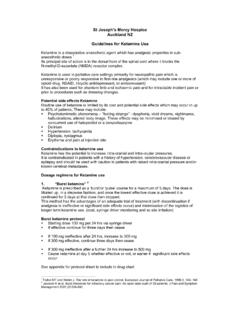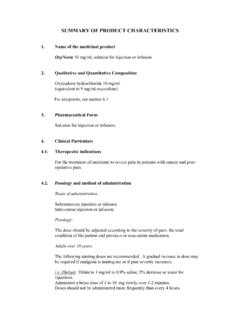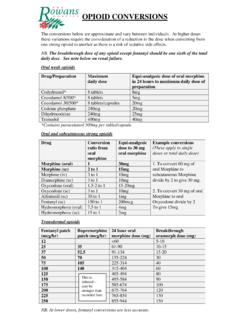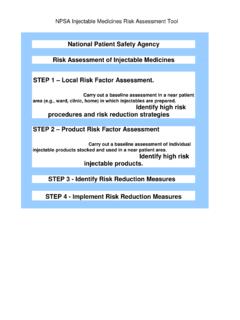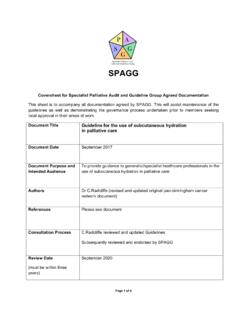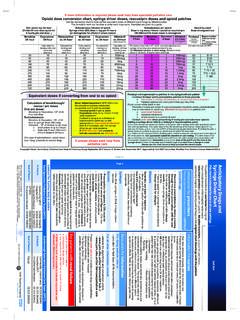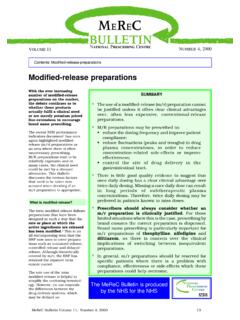Transcription of Use of dexamethasone formulations in palliative care: a ...
1 December 2014 Page 1 of 2 Use of dexamethasone formulations in palliative care: a response to recent changes dexamethasone formulations in the UK Oral (PO) tablets are formulated as dexamethasone base and injectable formulations as dexamethasone sodium phosphate. However, all dosing advice and labelling must now be expressed as dexamethasone base. There is additional potential for confusion because different injection strengths and brands are available which vary, in presentation, preservative/solvent content and storage requirement. This guide provides an overview of the use of dexamethasone in palliative care in adult patients. For use in other settings, seek appropriate specialist advice. Prescribing In palliative care, dexamethasone is generally the systemic corticosteroid of choice for anorexia, anti-emesis, obstruction of a hollow viscus, raised intracranial pressure and spinal cord compression.
2 The initial dose varies according to indication (Table 1). For more information about dose adjustment and duration of treatment, see the relevant sections in the palliative Care Formulary (PCF) systemic corticosteroids monograph. When parenteral use is necessary, dexamethasone is traditionally given subcutaneously (SC) rather than intramuscularly/intravenously (IM/IV). Traditionally, for ease of prescribing, conversion of PO to SC/IV dexamethasone was made on a 1:1 basis ( 4mg PO = 4mg SC/IV). Following recent labelling and formulation changes, the injectable formulations contain either or dexamethasone base (Table 2). Thus, continuing with an exact 1:1 conversion will lead to an unnecessarily complex and wasteful use of the ampoules and vials. Because the conversion between PO and SC/IV dexamethasone only requires the selection of a reasonable starting dose, PCF recommends that: for pragmatic purposes, when converting between PO and SC/IV routes, both and dexamethasone base of the injectable formulations can be considered approximately equivalent to dexamethasone base 4mg PO the SC/IV dose prescribed should take into account which injectable formulation is being used so as to avoid wasteful use of the vials/ampoules (Tables 1 and 2) the dose should be subsequently titrated according to response for consistency and to avoid confusion between colleagues and departments, clinicians should observe local guidelines and use the locally available injection formulation.
3 Continuous Subcutaneous Infusion (CSCI) CSCI compatibility of dexamethasone with other drugs: Because it is an alkaline drug, therapeutic doses of dexamethasone often cause compatibility problems. To minimize the risk of precipitation, it should always be the last drug added to an already dilute combination of drugs. In addition, different injectable formulations may react differently when mixed. dexamethasone has a long duration of action; therapeutic doses can generally be given as a bolus SC injection once daily, which avoids the risk of precipitation. To reduce CSCI site reactions, dexamethasone 1mg is sometimes added to other drugs, when compatibility data permits. For more information see PCF Chapter 20 (CSCI). December 2014 Page 2 of 2 Table 1 Typical PO and SC/IV starting doses for dexamethasone , expressed as dexamethasone basea Indication PO dose SC/IV dose (volume) formulation formulation Anorexiab 2 6mg 5mg ( ) ( ) Anti-emeticc 8 20mg (2 5mL) 19mg (2 5mL) Obstruction of hollow viscus 8 16mg (2 4mL) (2 4mL) Raised intracranial pressure 8 16mg (2 4mL) (2 4mL) Spinal cord compression 16mg (4mL) (4mL) a.
4 Generally given once daily in the morning (see text) b. prednisolone 15 40mg each morning is an alternative c. also see PCF Quick Prescribing Guide: Management of nausea and vomiting. Table 2 dexamethasone formulations suitable for SC use (UK) Aspen Hameln Hospira dexamethasone base Presentation (all glass) 1mL vial 1mL, 2mL ampoule 1mL ampoule 2mL vial Storage Refrigerate at 2 8oC <25oC <25oC Cost 2 1mL, 2mL, 5 1mL, 2mL, 5 a. dexamethasone base dexamethasone sodium phosphate 5mg b. dexamethasone base dexamethasone sodium phosphate Supply dexamethasone (generic) Tablets 500microgram, 2mg, 28 days @ 2mg once daily = 24. Oral solution ( sugar - free ) 2mg/5mL, 28 days @ 2mg once daily = 40. Injection see Table 2. Further details MHRA (2014) dexamethasone 4mg/mL injection (Organon Laboratories Limited: reformulation with changes in name, concentration, storage conditions, and presentation.)
5 Drug Safety Update. 3. UK Medicines Information (2014) dexamethasone injection. In use product safety assessment report.
